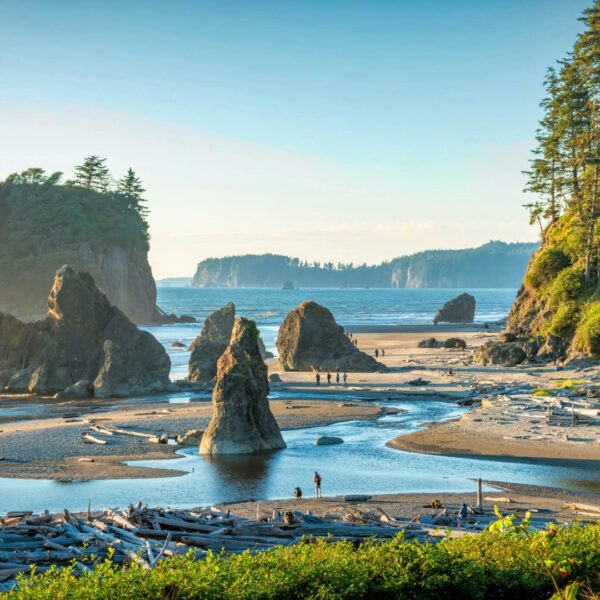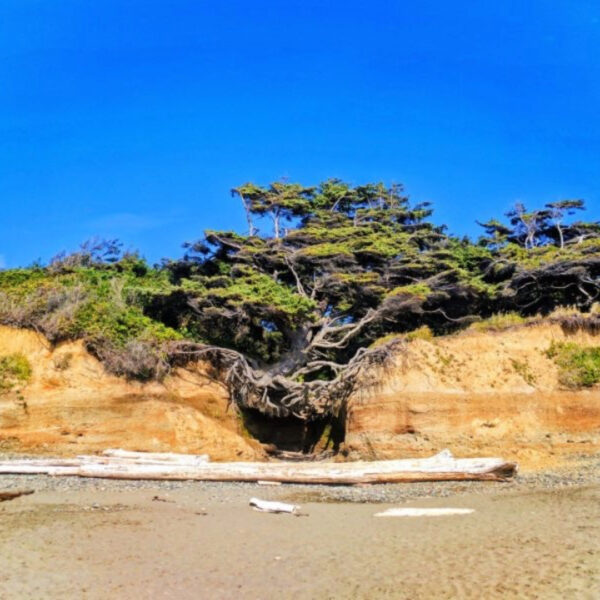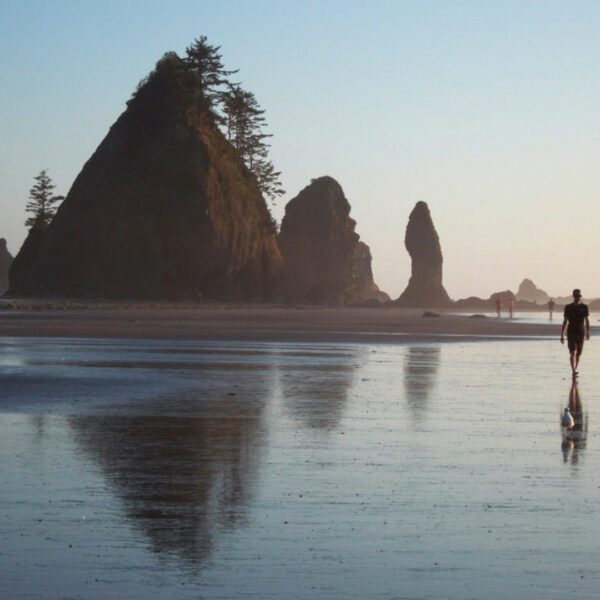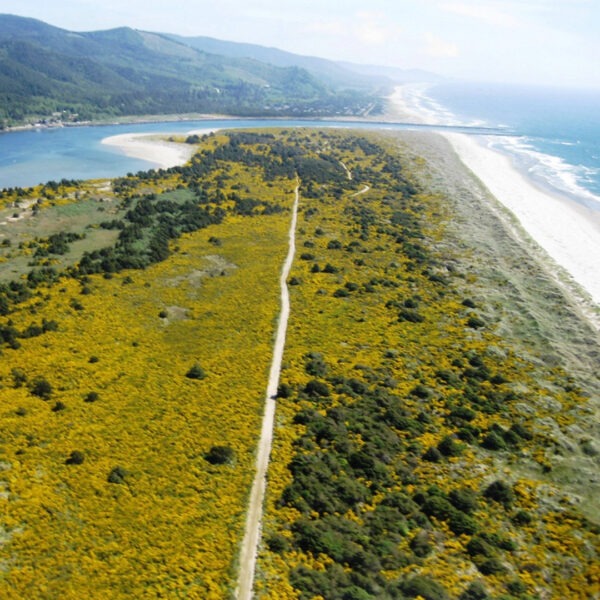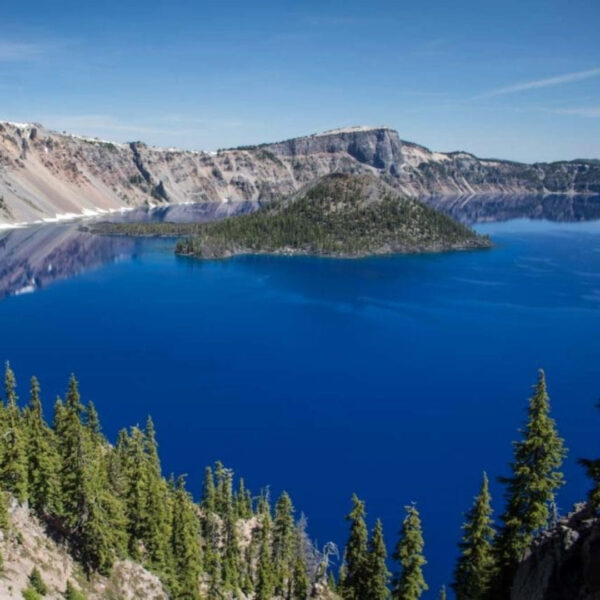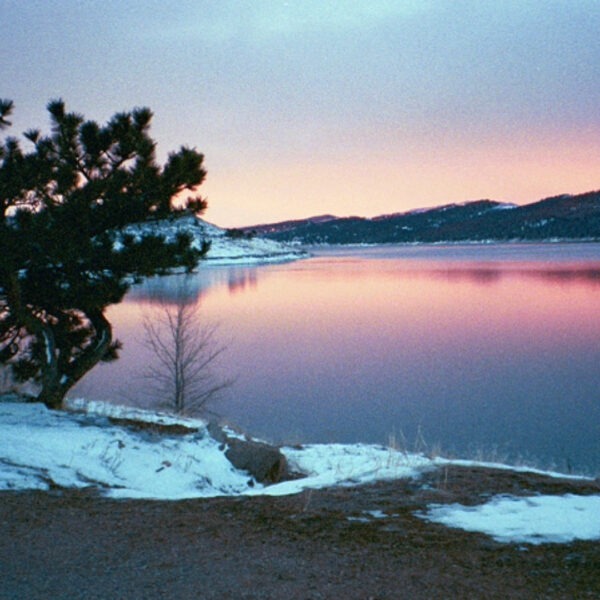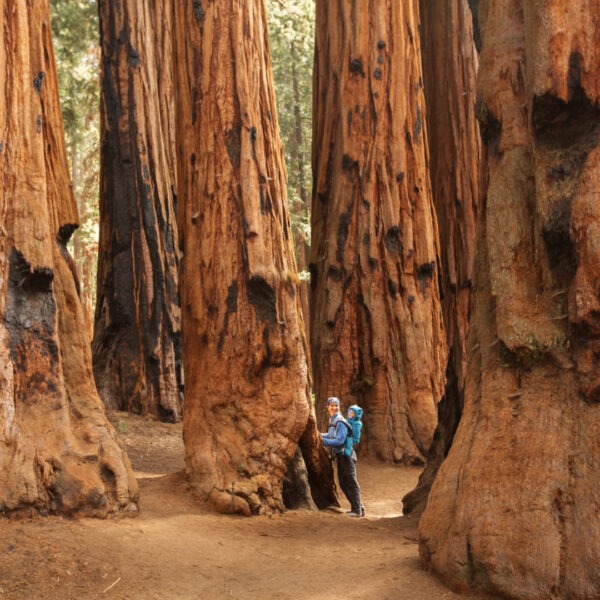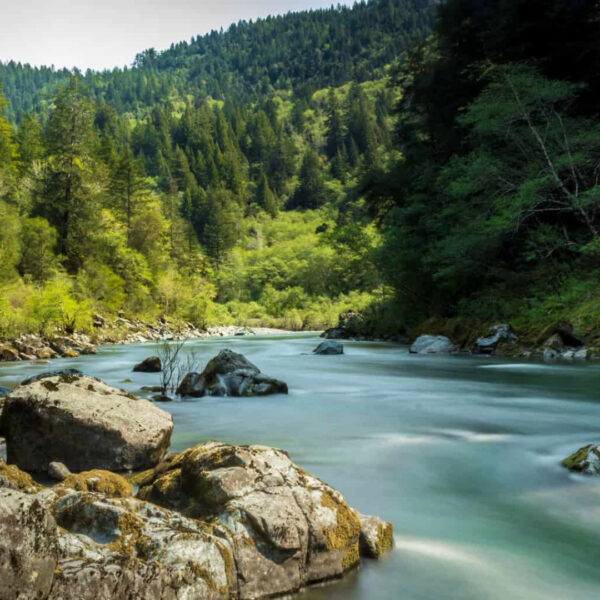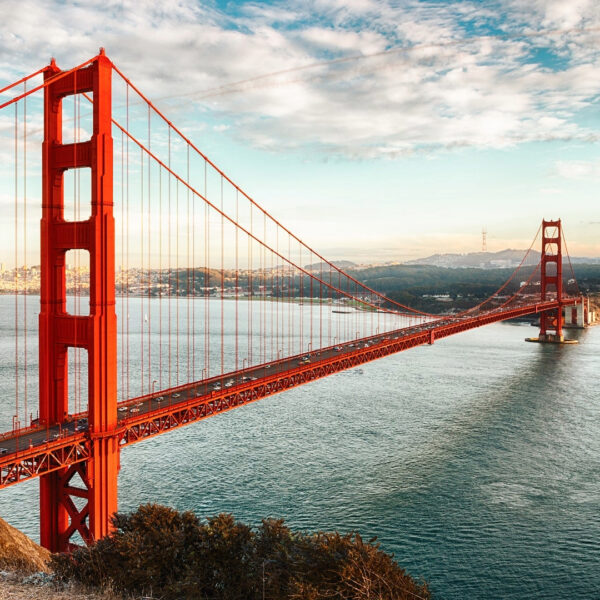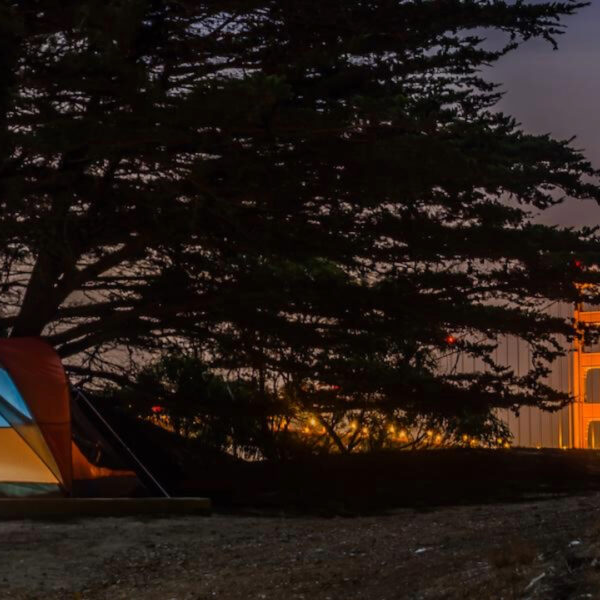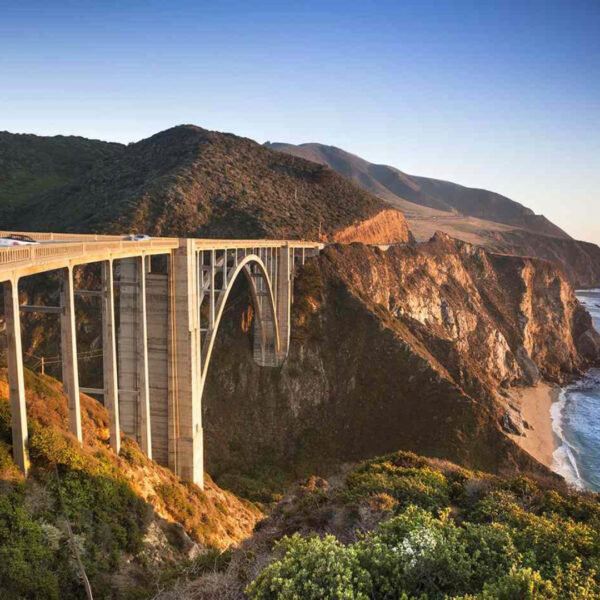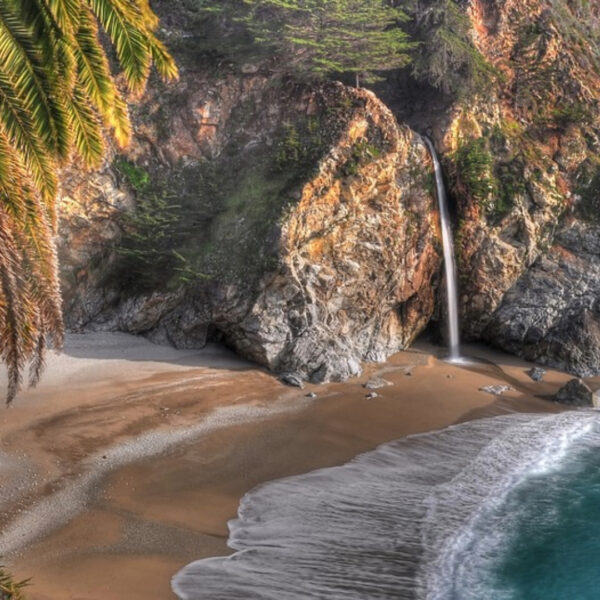This guide is designed for overlanders and campers planning the ultimate road trip from Vancouver Island to Baja California. Whether you’re seeking scenic views, great camping spots, or just looking to escape the cold, this journey offers everything you need.
In Part 1, we covered the first stretch from Vancouver Island down to Deception Pass, showcasing some of the best routes and camping options along the way. Now, in Part 2, we’ll take you further into the heart of the Pacific Northwest and beyond, as we make our way toward Central California. Stops in this section include Olympic National Park, the Oregon Coast (Cannon Beach), Crater Lake, the Redwood Forests, San Francisco, and finally Big Sur. Let’s dive into the next stage of your overlanding adventure!
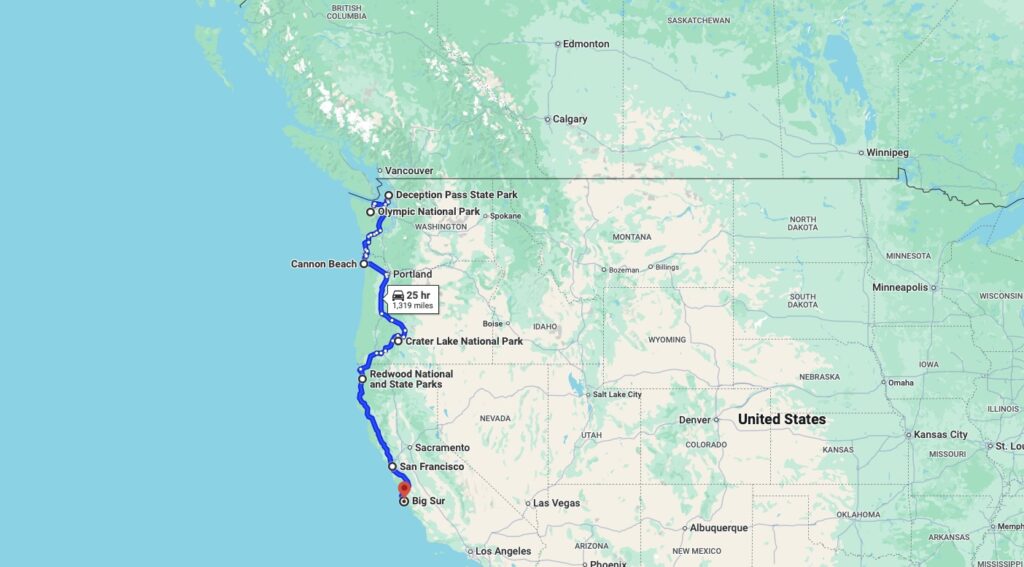
As we continue our journey from Deception Pass—the final stop in Part 1 of our guide—our next destination takes us deeper into the heart of the Pacific Northwest. The road from Deception Pass State Park to Olympic National Park offers scenic views of both land and sea. To get there, head south on WA-20 West and take the Port Townsend-Coupeville Ferry to the Olympic Peninsula. Once on the peninsula, follow WA-101 westward. The drive takes about 2.5 to 3 hours, depending on ferry schedules, and provides plenty of beautiful landscapes to admire along the way.
Ferry Costs (Port Townsend-Coupeville Ferry in CAD):
- Standard vehicle (under 20 ft): Around CAD 20 to 27.
- 4×4 truck or SUV: Roughly CAD 45 to 65, depending on the height and length.
- Camper or RV (over 20 ft): Prices start at CAD 85 and increase based on vehicle size.
1. Olympic National Park (Washington, USA)
Why stop here?
Olympic National Park is a dream for nature lovers. The park has everything from rainforests to coastlines and mountain peaks. You can walk through the Hoh Rainforest, relax on beaches like Kalaloch or Ruby Beach, or hike up the trails at Hurricane Ridge. It’s a must-visit for overlanders and campers who love forests, wildlife, and amazing scenery. Skipping this stop means missing out on one of the most diverse parks in the U.S.
Camping Options (November 15):
Kalaloch Campground:
- Open all year, this campground is right by the ocean, offering amazing views. It’s great for both overlanders and campers.
- Rates: $24 to $48 per night.
Hoh Rainforest Campground:
- For a more peaceful rainforest experience, this campground is also open year-round. It’s first-come, first-served in November.
- Rates: Around $20 per night.
In Olympic National Park, overlanding is only allowed in designated campgrounds like Kalaloch and Hoh Rainforest Campgrounds, where you can safely park your vehicle and set up your roof tent. These spots are overlanding-friendly, offering plenty of space for vehicles, rooftop tents, and access to facilities like restrooms and water. While you can’t camp in non-designated wilderness areas, these established sites provide a secure environment, especially in November when weather conditions can change quickly. Sticking to these campgrounds ensures a safer, more comfortable experience as you enjoy the natural beauty of the park. From here, the journey continues to the stunning Oregon Coast.
2. Oregon Coast (Cannon Beach)
Why stop here?
Cannon Beach on the Oregon Coast is a must-see for anyone who loves the ocean. Famous for Haystack Rock, a massive rock formation rising from the shoreline, it’s one of the most iconic spots on the Pacific Coast. The beach itself is wide and sandy, perfect for a peaceful walk, taking in the sound of the waves, or even surfing. While the water can be chilly in November, you’ll still see surfers catching waves year-round, especially in wetsuits. The sunsets here are unforgettable, with the ocean glowing under the evening light. Cannon Beach is ideal for overlanders and campers who want to experience the calm beauty of the Pacific and enjoy the relaxing coastal atmosphere. Missing this stop means missing out on one of the most picturesque beaches in the U.S.
Fastest Route (Olympic National Park to Cannon Beach):
To get from Olympic National Park to Cannon Beach, take WA-101 South along the Pacific Coast Highway, following the scenic coastline. This drive is full of beautiful views and nature stops. You can stop at Astoria, a historic town where the Columbia River meets the Pacific Ocean, offering a great place to stretch your legs and take in the sights.
- Approximate time: 4 to 4.5 hours, depending on traffic.
Camping Options (November 1st):
- A simple, family-owned campground located just a short distance from Cannon Beach. This quiet spot is perfect for those who want to stay close to the beach while enjoying a peaceful, wooded camping experience.
- Rates: Around CAD 50 to 65 per night for tents or small vehicles.
- Located just south of Cannon Beach, this state park offers campsites with ocean views and easy access to the beach. It’s a great spot for both overlanders and campers with larger setups.
- Rates: Around USD 30 to 45 per night, depending on the size of your vehicle.
Overlanding and Safe Parking for Roof Tents
For overlanders, both Wright’s for Camping and Nehalem Bay State Park offer safe, designated spots to park and set up your roof tent. These campgrounds are overlander-friendly, providing enough space to comfortably park larger vehicles and rooftop tents. You’ll also find restrooms, water, and other basic facilities, making it a convenient and safe choice, especially in November. As always, avoid parking and setting up in non-designated areas, as coastal weather can be unpredictable, and these sites are designed to keep you safe during the colder months.
From Cannon Beach, we head south to our next stop—Crater Lake, one of the most stunning destinations in Oregon.
3. Crater Lake National Park (Oregon, USA)
Why stop here?
Crater Lake is one of the most stunning and unique natural wonders in the U.S. It’s known for its deep blue water, created by the collapse of a volcano thousands of years ago, forming the deepest lake in the U.S. The sight of Wizard Island, a small volcanic island in the lake, is truly unforgettable. In November, the area can start to get chilly, but the crisp air and fewer crowds make it a peaceful stop. This park is perfect for those who enjoy hiking, scenic drives, and quiet moments of reflection. Overlanders and campers will love the wide-open spaces and incredible views. Missing Crater Lake means missing out on one of the most beautiful, peaceful places in Oregon.
Fastest Route (Cannon Beach to Crater Lake):
To get from Cannon Beach to Crater Lake National Park, take US-101 South along the coast, then head inland via OR-38 East and OR-138 East towards Crater Lake National Park. While it’s a longer drive, the route offers great scenery, including coastal views and riverside landscapes. You can stop at Reedsport for a break, where the Oregon Dunes National Recreation Area offers an amazing landscape of sand dunes and forest trails—perfect for a quick adventure.
- Approximate time: 6 to 7 hours.
Camping Options (November 15):
Mazama Campground:
- While Crater Lake’s Mazama Campground usually closes in mid-October, it’s worth noting if you’re visiting earlier in the season. It offers scenic views and is perfect for both overlanders and campers.
- Rates: $21 to $31 per night when open.
Diamond Lake Campground:
- Located about 45 minutes from Crater Lake, this campground is open year-round and offers camping options for vehicles, tents, and overlanders. It’s the best option for November when most Crater Lake campgrounds are closed.
- Rates: $20 to $30 per night.
Overlanding and Safe Parking for Roof Tents
For overlanders, Diamond Lake Campground offers great spots to park your vehicle and set up a roof tent. You’ll have plenty of room to set up, and the campground provides basic facilities like restrooms and water. Crater Lake itself does not allow dispersed camping, so it’s important to use these designated campgrounds for safety and to avoid the winter weather that can come early in this area.
Overlanding Activities
Crater Lake is a great spot for scenic drives, especially along Rim Drive, which circles the lake and offers amazing views at every turn. You’ll also find hiking trails like the Garfield Peak Trail, which offers stunning views of the lake. Overlanders who enjoy photography will find endless opportunities to capture the beauty of the lake and surrounding mountains. In November, be prepared for colder temperatures, and check road conditions as some routes may be closed due to snow.
Next, we head further south to explore the majestic Redwood National and State Parks, where towering trees and lush forests await.
4. Redwood National and State Parks (California, USA)
Why stop here?
The Redwood National and State Parks are home to the tallest trees on earth, offering a peaceful escape into nature that you can’t find anywhere else. Walking among these ancient giants is awe-inspiring, with some trees towering over 350 feet. The parks also feature lush fern canyons, river views, and quiet coastal stretches, making it an ideal stop for overlanders and campers who love being immersed in deep forests. This stop is for anyone who wants to connect with nature and experience the serenity of some of the oldest living things on the planet.
Fastest Route (Crater Lake to Redwood National and State Parks):
From Crater Lake, head south on OR-62 and merge onto US-199 South through Oregon and into California. This route will take you through scenic mountain roads and forests before reaching the redwoods. If you want a quick stop along the way, the town of Cave Junction in Oregon offers a visit to the Oregon Caves National Monument, where you can explore a marble cave system, and a unique and interesting break in the drive.
- Approximate time: 4.5 to 5 hours.
Camping Options (November 15):
- Jedediah Smith Campground:
- Located within the Redwood National and State Parks, this campground is open year-round and offers beautiful spots near the Smith River. It’s a great place for overlanders to park and set up their roof tents or campers.
- Rates: Around CAD 50 to 60 per night.
- Elk Prairie Campground:
- Another great option, is located in Prairie Creek Redwoods State Park. This campground is perfect for those who want to be surrounded by towering trees. It’s accessible for both tents and vehicles, including overlanders with rooftop tents or campers.
- Rates: CAD 45 to 55 per night, depending on the season and vehicle size.
Overlanding and Safe Parking for Roof Tents
Both Jedediah Smith and Elk Prairie Campgrounds are overlanding-friendly, offering designated spots for vehicles with rooftop tents or campers. You’ll find well-maintained facilities like restrooms, picnic areas, and water stations, making it a comfortable stop even in colder November weather. Dispersed camping isn’t allowed in the park, so it’s important to stay in these designated campgrounds. The peaceful forest setting at both locations provides a serene, safe place to set up your roof tent or camp overnight.
Overlanding Activities
The redwoods offer plenty of opportunities for scenic drives, hikes, and photography. The Newton B. Drury Scenic Parkway is a popular overlanding route that takes you through the heart of the forest. Overlanders can enjoy hiking trails like the Fern Canyon trail, which is famous for its lush, moss-covered walls, or the Boy Scout Tree Trail, which leads you deep into the redwood groves. Be prepared for cooler temperatures and rain in November, so pack accordingly.
Next, we head south towards San Francisco, where urban exploration meets beautiful coastal views.
5. San Francisco (California, USA)
Why stop here?
San Francisco is a must-stop for anyone travelling down the Pacific Coast. Known for its iconic Golden Gate Bridge, lively neighbourhoods, and stunning views of the bay, this city offers a mix of urban exploration and natural beauty. For overlanders, it’s a great place to take a break from the wilderness and enjoy some sightseeing, dining, and culture. Whether you’re walking along the famous Fisherman’s Wharf, exploring Alcatraz, or driving down the winding Lombard Street, San Francisco has something for everyone. Missing this stop means skipping one of California’s most famous cities.
Fastest Route (Redwood National and State Parks to San Francisco):
From Redwood National and State Parks, head south on US-101 South, following the scenic coastal highway through Northern California. You’ll pass through beautiful coastal towns like Eureka and Mendocino. If you have time, stop at the Lost Coast, a remote stretch of coastline known for its rugged beauty. Continue south until you reach San Francisco.
- Approximate time: 5 to 6 hours.
Travel Costs:
- Golden Gate Bridge Toll: Around CAD 10 to 12 for crossing the bridge into the city.
Camping Options (November 15):
- Kirby Cove Campground:
- Located just north of the Golden Gate Bridge, this campground offers incredible views of the bridge and the city. It’s perfect for overlanders who want to stay close to the action while still enjoying nature.
- Rates: Around CAD 40 to 50 per night.
- Samuel P. Taylor State Park:
- Located about 30 minutes north of San Francisco, this state park offers camping options with redwoods and scenic hiking trails. It’s a great spot for overlanders looking for a quieter place to camp while staying near the city.
- Rates: Around CAD 35 to 45 per night.
Overlanding and Safe Parking for Roof Tents
Kirby Cove Campground and Samuel P. Taylor State Park both offer safe, designated areas for overlanders to park and set up roof tents or campers. These campgrounds provide essential amenities like restrooms, picnic areas, and fire pits, making it comfortable for a quick overnight stay. While dispersed camping isn’t available in the city, these campgrounds allow you to enjoy the best of both worlds—staying close to nature and within easy reach of San Francisco’s top attractions.
Overlanding Activities
San Francisco offers a variety of activities for every type of traveller. For overlanders, driving across the Golden Gate Bridge is a must, followed by a visit to the Marin Headlands for breathtaking views of the bridge and the bay. You can also explore the nearby Point Reyes National Seashore for hiking and wildlife viewing or spend the day exploring the city’s famous landmarks like Chinatown, Golden Gate Park, or the Palace of Fine Arts. Be sure to check parking availability if you’re in a larger overlanding rig, as city streets can be narrow.
From San Francisco, we’ll continue our journey south toward the dramatic cliffs and coastal views of Big Sur, one of the most beautiful stretches of the Pacific Coast.
6. Big Sur (California, USA)
Why stop here?
Big Sur is one of the most breathtaking coastal regions in the world. Known for its dramatic cliffs, stunning ocean views, and scenic drives along the Pacific Coast Highway, it’s a must-stop for overlanders and campers. The stretch between San Francisco and Big Sur offers miles of unspoiled coastline, where mountains meet the Pacific Ocean, creating a landscape that feels otherworldly. Overlanders will love the sense of freedom that comes from driving along this open road, with plenty of pullouts to stop and take in the views. Whether you’re exploring the beaches, hiking to McWay Falls, or camping under the stars, Big Sur offers an unforgettable experience.
Fastest Route (San Francisco to Big Sur):
From San Francisco, take US-101 South towards Monterey and then follow California State Route 1 (Pacific Coast Highway) along the coast. Along the way, you’ll pass through iconic stops like Half Moon Bay and Carmel-by-the-Sea, both worth a visit if time allows. Once you reach Big Sur, you’ll be greeted by some of the most stunning coastal views in California.
- Approximate time: 3 to 4 hours.
Camping Options (November 15):
- Pfeiffer Big Sur State Park:
- One of the most popular campgrounds in Big Sur, this park offers plenty of camping options for both overlanders and campers. You’ll be surrounded by redwoods, with easy access to hiking trails and the Big Sur River.
- Rates: Around CAD 55 to 65 per night.
- Kirk Creek Campground:
- Known for its stunning cliffside views of the Pacific Ocean, Kirk Creek is a perfect spot for overlanders wanting to park their vehicle right by the coast. The campground is more primitive, but the ocean views more than make up for it.
- Rates: Around CAD 45 to 55 per night.
Overlanding and Safe Parking for Roof Tents
Both Pfeiffer Big Sur State Park and Kirk Creek Campground are ideal for overlanders. They offer designated spots to park your vehicle and set up your roof tent, with facilities like restrooms and picnic tables. Kirk Creek provides an unbeatable oceanfront experience, while Pfeiffer Big Sur offers a more secluded forest setting. Dispersed camping isn’t allowed in the area, so it’s important to stick to these official campgrounds for safety and to respect the environment.
Overlanding Activities
Big Sur is known for its incredible hiking trails and coastal views. Overlanders can take a break from driving and hike to McWay Falls, a stunning waterfall that drops right into the Pacific Ocean. Another popular hike is the Pfeiffer Falls Trail, which takes you through redwoods and offers peaceful forest views. For those interested in photography, Bixby Creek Bridge is one of the most photographed bridges on the West Coast. In November, the weather is cooler but still perfect for exploring, so make sure to pack layers for the chilly coastal breezes.
This journey through the Pacific Northwest and California’s northern coast has taken you from the towering redwoods to the rugged cliffs of Big Sur, with each stop offering its unique beauty and adventure. Whether you’re overlanding or camping, these locations provide the perfect mix of nature, relaxation, and exploration. But our journey doesn’t end here.
The next leg of the trip will take us even further south, into the heart of Southern California and finally to Baja California, where the desert meets the sea. Stay tuned for Part 3 of our overlanding adventure, where we’ll explore new landscapes, discover hidden camping spots, and provide all the guidance you need for the ultimate trip to Baja California. Whether you’re already planning your trip or just dreaming of the open road, this series will give you everything you need to make your overlanding journey unforgettable.
Stay tuned for the final chapter of our Vancouver to Baja California adventure!

